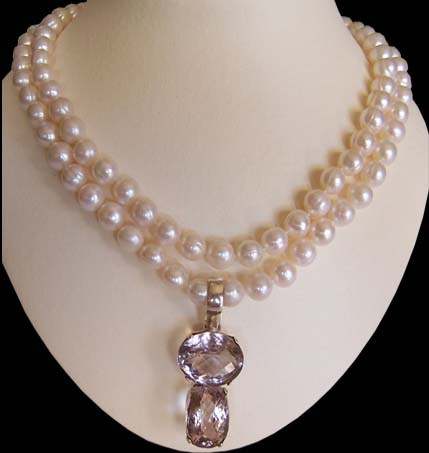
Home > pearl > Pearl Jewelry Buyers Guide
Pearl Jewelry Buyers Guide
Posted on Thursday, November 10, 2011 by admin

A symbol of purity, virtue and modesty, pearls are a sought-after natural material which makes pearl jewelry exceptionally popular. Technically known as "organic gems", pearls are harvested from shellfish just as they have been for over 4,000 years. That said, much has changed in the millennia since the discovery of this natural treasure including the way pearls are harvested, how they are used in pearl jewelry and how that jewelry is worn. To get a strong understanding of what to look for when shopping for jewelry like pearl earrings, bracelets and earrings, let's consider: the basics of pearls, followed by the most popular form of pearl jewelry and finally how to select them.
Pearl Jewelry Basics
Pearls are clearly one of nature's great treasures, but with a wide range of colors, shapes and sources it's easy to get confused about what to look for in pearl jewelry. Starting with the basics we'll look at how a pearl is formed, the sources and types of pearls, their valuation and how this affects the value of pearl jewelry.
















How a Pearl is Formed
The creation of a pearl is remarkably simple to understand, but fairly complex to create. A pearl is formed when an irritant, such as a piece of sand, becomes lodged in the shell of an oyster. Sensing the object, the oyster deposits layers of a semi-translucent substance called "nacre" around the intruder, where it builds up over time. It commonly will take years to create a pearl of decent size and perfectly round shapes are rare. As a result, pearl bracelets and necklaces with perfectly round pearls are quite expensive forms of pearl jewelry.
Natural vs. Cultured Pearls
Unknown to most wearers of pearl jewelry, the majority of pearls used today are farmed and not naturally grown. Generally speaking, natural pearls are not widely available due to years of over-fishing and the great demand for perfectly round pearls for use in jewelry. During the start of the 20th century, a new process for growing pearls was developed resulting in what is now known as cultured pearls. Essentially the process involves inserting an irritant into an oyster and then caring for that oyster until it has developed a pearl. Today, almost all pearl jewelry uses cultured pearls.
Types of Pearls Used in Pearl Jewelry
When searching for pearl jewelry, you'll find that pearls differ in color, size and shape based on the variety of the mollusk, the growing conditions, harvesting techniques and many other factors. Akoya, Cortez, Mabe, South Sea and Tahitian pearls are some of the most popular varieties, each of which has its own set of qualities. Akoya pearls are typically white or cream, but they can also be grey or black. Cortez pearls are available in a range of colors, including a shimmering black pearl. Mabe pearls possess a very high luster, while South Sea pearls are among the largest cultured pearls and can be white, cream or gold. Tahitian pearls are naturally grey, silver or black. The most sought-after Tahitian pearl is black with peacock green overtones. As you can see, pearl jewelry choices can move well beyond the traditional white pearl necklace to include an array of choices that include different colors, sizes and finishes.
Classic Pearl Jewelry: Necklaces
Understandably, pearls are popular with jewelry fans across the world, but no piece of pearl jewelry has captured the imagination of women more than the traditional pearl necklace. Having always possessed a reputation for elegance, pearl necklaces captured the world's imagination with the release of 1961's Breakfast at Tiffany's. In that movie, star Audrey Hepburn defined style with a stunning pearl necklace that would squarely place this piece of jewelry in American pop culture history. Ever since, the necklace has been the favorite piece of pearl jewelry.
Even though necklaces are the favored form of jewelry using pearls, there are still quite a few types. Here's a quick description of each:
Bib: A Bib necklace consists of several strands of pearls of varying lengths.
Collar: Consisting of multiple strands of pearls, Collar necklaces were very popular during the Victorian era and are worn high on the neck. Most examples of this type of necklace are 12-13 inches long.
Choker: Similar to a collar necklace, a Choker is worn somewhat lower on the neck and is 14-16 inches long.
Princess: Recognized as the classic length for a pearl necklace, the Princess lies slightly below the neck. A versatile necklace, the Princess can be matched with many different styles of clothing with varying necklines. This type of necklace is 17-19 inches long.
Matinee: This style is routinely seen in more formal and semi-formal situation with both suits and dresses. The Matinee necklace is approximately is 20-24 inches long.
Opera: Falling below the bust line, the Opera necklace tends to be worn at formal occasions. For less formal occasions and daytime wear, the Opera can be knotted or the strand can be doubled over. This necklace is 30-36 inches long.
Rope: The longest of all pearl necklace styles, the Rope necklace can be doubled, as well as knotted to reduce its length of 36 + inches long.
Clearly, some homework must be performed to find the right piece of pearl jewelry, but armed with this information your search should be much easier. Next, let's look at pearl valuation and how to make a wise purchase decision.
How to Buy Pearl Jewelry
Since the vast majority of modern pearl jewelry uses cultured pearls, a solid understanding of how they are valued will come in handy when shopping for a set of pearl earrings, a pearl bracelet or some other form of jewelry that uses pearls. Here are some guidelines that will be helpful when selecting pearl jewelry:
Pearl Luster: This is the most important feature of a pearl and should be your primary concern. Luster is the sharpness and intensity of reflections on the pearl's surface; to recognize a finer luster, look at the clarity of images that are reflected in the pearl's surface. The closer to a mirror image you see, the better the luster. Pearls with fine luster also seem to glow warmly from within.
Pearl Size: The size of the pearls used in any piece of jewelry is important for both aesthetic and financial reasons. Larger pearls are normally preferred for necklaces, however they may be considered less desirable for earrings, since they can often divert attention away from the wearer. In addition, larger pearls integrated into pearl rings are attractive but are often bulky and difficult to wear. Finally, the larger the pearl the greater the cost, so the educated shopper should balance the size of the pearl with the expected cost.
Pearl Similarity: When searching for pearl jewelry, one should look at how well matched pearls are when combined in jewelry. With many subtleties in color, shape and finish, even a slight difference can create an unbalanced appearance. Look for pearls that are similar, while keeping in mind that those that closely match will be more expensive.
Jewelry Style: Finally, having settled on a piece of pearl jewelry, it’s a good idea to consider the recipient’s taste in clothing to ensure that the jewelry selected will enhance that persons'wardrobe.For example, a traditional choker of white pearls would go well with a more formal business outfit, while a pair of chocolate pearl earrings would be much more versatile. So consider how the jewelry will be worn.
Pearl jewelry is a favorite for many, however navigating the many facets of finding the right piece can often feel complicated. By learning some pearl basics and then creating a familiarity with this popular form of jewelry, you will be well prepared to find a beautiful necklace, bracelet or set of earrings and have fun doing it.
Category Article jewelry, pearl

Popular Posts
-
Kim Zolciak showed off her engagement ring on Twitter. Is it bigger than that other Kim's engagement ring? Zolciak got engaged to Atla...
-
Titanium is versatile, lightweight and strong, with a silvery-white metallic color. This metal is as strong as steel but is 45% lighter in ...
-
Metals play a critical role in the creation of contemporary jewelry by affecting appearance, durability and cost. With such a dramatic impac...
-
Birthstone jewelry is very popular today and dates back to ancient history. Throughout the ages people have had the strong desire to adorn t...
-
Gold has the longest and most storied history of all precious metals. It is soft enough to be worked into interesting shapes, and its warm ...
-
The most precious metal commonly found in jewelry is the silvery-white metal platinum . It is a relative newcomer to jewelry, having become ...
-
A symbol of purity, virtue and modesty, pearls are a sought-after natural material which makes pearl jewelry exceptionally popular. Technica...
-
Incorporating many beautiful gemstones found from across the world, gemstone jewelry is among the most popular forms of jewelry. Providing a...
-
The standard for sterling silver has remained unchanged since 1300 when Edward I of England established an early trade practice rule for si...
-
White gold has the same properties as yellow gold, but it has been mixed with different metals to give it a white color. Instead of the cop...









